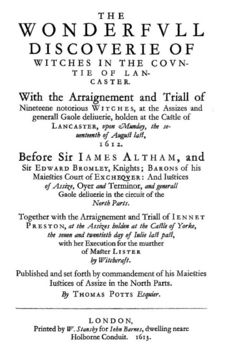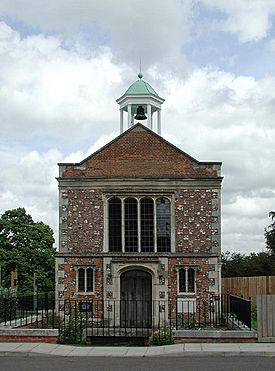James Altham facts for kids
Quick facts for kids
Sir James Altham
|
|
|---|---|
| Baron Altham | |
| Born | City of London |
| Died | Oxhey Hall Place, Hertfordshire, England |
| Wife | Margaret Skinner Mary Stapers Helen Saunderson |
| Father | James Altham |
| Mother | Elizabeth Blancke |
| Occupation | barrister judge member of parliament |
Sir James Altham (born around 1554, died 1617) was an important English judge. He lived in Oxhey, Hertfordshire. For a short time, he was also a member of the Parliament of England. From 1607, he became a Baron of the Exchequer, which was a high legal position.
Sir James Altham was a friend of Lord Chancellor Francis Bacon. He often disagreed with another famous judge, Edward Coke. Altham worked to improve the laws of fairness, known as equity, within the Exchequer courts. He also helped the King, James I, to strengthen royal power and collect taxes. In 1612, along with Sir Edward Bromley, he was a judge in the famous Lancashire witch trials.
Contents
Early Life and Family
James Altham came from a family in Girlington, Yorkshire. He was the third of five sons. His father, also named James Altham (died 1583), was a successful merchant and a member of the Worshipful Company of Clothworkers. His father served as Sheriff of London and High Sheriff of Essex.
James's mother was Elizabeth Blancke. She was the daughter of Thomas Blancke, a London merchant. Elizabeth died in 1558 when James was young. His father later married Mary Matthew. This made James step-brother to Mary Langton.
On June 16, 1584, James Altham married his first wife, Margaret Skynner.
Education and Early Career
James Altham followed his older brothers to the University of Cambridge. He studied at Trinity College, Cambridge in 1571. Later, he joined Gray's Inn in 1575 to study law. He became a lawyer, called to the bar, in 1581.
In 1589, he was elected as a Member of Parliament (M.P.) for Bramber in Sussex. We don't have many records of what he did in Parliament. However, he helped draft several new laws in 1601.
Legal Career Highlights
Becoming a Judge
In 1600, James Altham became a "reader" at Gray's Inn, which was a teaching role for lawyers. In 1603, he was made a serjeant-at-law. This was a very important step for lawyers at the time.
On February 1, 1607, he was appointed as one of the barons of the exchequer. This meant he became a high-ranking judge. He was also knighted, becoming "Sir" James Altham.
Important Cases
In 1610, Sir James Altham was part of a group of judges who looked at a big question. This question was about whether the King could create new laws just by making a public announcement, called a proclamation. The judges, including Altham, decided that the King could not create new crimes this way. They stated that the King's power must follow the law of the land.
In 1611, Altham was one of the judges who gave an opinion on cases involving people with different religious beliefs.
In 1612, Sir James Altham and Sir Edward Bromley were the main judges in the Lancashire witch trials. These trials took place in Lancaster. Twenty people were accused of being witches. Eleven of them were found guilty and were executed. The judges asked the court clerk, Thomas Potts, to write a detailed report of the trials. This report was published in 1613.
In 1616, Altham and other judges were involved in a case about the King's power to stop court cases. The judges wrote a letter to King James I. They said that the King could not stop court cases just because they affected his royal power. All the judges, except for Edward Coke, eventually agreed with the King after a meeting.
Oxhey Estate and Chapel
Sir James Altham bought the estate of Oxhey, near Watford, Hertfordshire, in 1604. He then built a very large house there called Oxhey Place Hall. It cost him a lot of money, about £3000. The house had an orchard and a garden surrounded by a brick wall. This house was later taken down and replaced by a different mansion.
In 1612, Altham also built a private chapel at Oxhey. This chapel is still standing today, though it has been changed and repaired over time. It has beautiful furnishings from the late 1600s.
Death and Memorial
Sir James Altham died on February 21, 1617. Sir Francis Bacon, a very important legal figure, described him as "one of the gravest and most reverend of the judges of this kingdom."
He was buried in Oxhey Chapel. There is a large monument there to remember him and his last wife, Helen. The monument shows Sir James and his wife kneeling in prayer. Sir James is wearing his red judge's robes. The monument is made of marble with different colors and carvings.
His last wife, Dame Helen, died on April 21, 1638.
Family Life
Sir James Altham had children with his first two wives.
With his first wife, Margaret Skinner, he had one son:
- James Altham, who later became Sir James Altham of Oxhey. This Sir James Altham married Elizabeth Sutton. They had a son who died young, and two daughters:
- Elizabeth Altham married Arthur Annesley. Their second son, Altham Annesley, was given the title Baron Altham in 1680.
- Frances Altham married Richard Vaughan, 2nd Earl of Carbery.
With his second wife, Mary Stapers, he had three children:
- Richard Altham, who died without having children.
- Elizabeth Altham married three times. Her last husband was Sir Robert Bernard, 1st Baronet.
- Mary Altham married Sir Francis Stydolph. She was the mother of Sir Richard Stydolph, Baronet.
Sir James Altham had no children with his third wife, Helen Saunderson.



